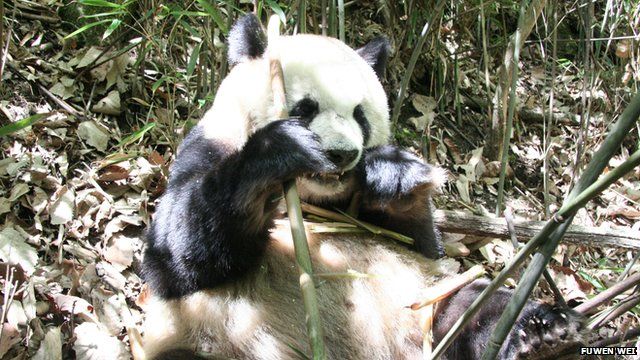Lazy lifestyle key to pandas' bamboo-only diet
- Published

Scientists have uncovered the key reason why giant pandas are able to survive solely on a diet of bamboo.
The researchers found that pandas get by on shoots and leaves because they expend extremely small amounts of energy.
A typical adult panda burns up about 38% of the calories used by other, similarly sized animals.
The scientists found the bears' slow-moving ways were linked to low levels of thyroid hormones.
Scientists have long been intrigued as to how the black and white mammals are able to live exclusively on hard-to-digest bamboo, since their stomachs still retain the gut bacteria of the omnivorous creatures they evolved from.
This new analysis sheds light on the mystery.
'Frugal with energy'
The researchers looked at the daily energy expenditure of five captive pandas and three living in the wild.
They found that the creatures used around 38% of the predicted value for mammals of their size. This compares to slow-moving koalas, which use around 69% of the energy normal for similarly sized animals.
The most direct comparison with the pandas' laid-back ways were three-toed sloths, which have a similarly minimal energy consumption for their size.
When the researchers measured the panda's rates of movement they found they were only active 49% of the time, and when they did move, their average speed was a less-than-blistering 20 metres per hour.
"Pandas save a lot of energy by being frugal with the energy they spend on physical activity," said Prof John Speakman, from the University of Aberdeen and Chinese Academy of Sciences, one of the study's lead authors.
"However, it is not only their low activity that contributes to their low metabolism; the metabolic rate of an active panda is still lower than a completely stationary human.
"We found that their low metabolism is correlated with very low levels of thyroid hormones, which was linked to a genetic mutation in the thyroid hormone synthesis pathway that is unique to the panda."
These hormone levels were the equivalent to those found in hibernating black bears.
Pandas in captivity were even less inclined to move about, rising off their bottoms for only about one third of the time they were studied.
The researchers also discovered that the panda's brain, liver and kidneys are relatively small compared to other bears.
According to WWF, there are around 1,800 pandas left in the wild in China.
The findings were reported in the journal Science.
Follow Matt on Twitter @mattmcgrathbbc.
- Published31 October 2014
- Published25 June 2015